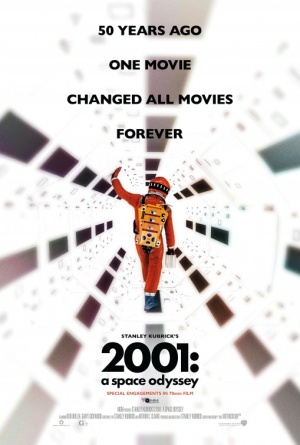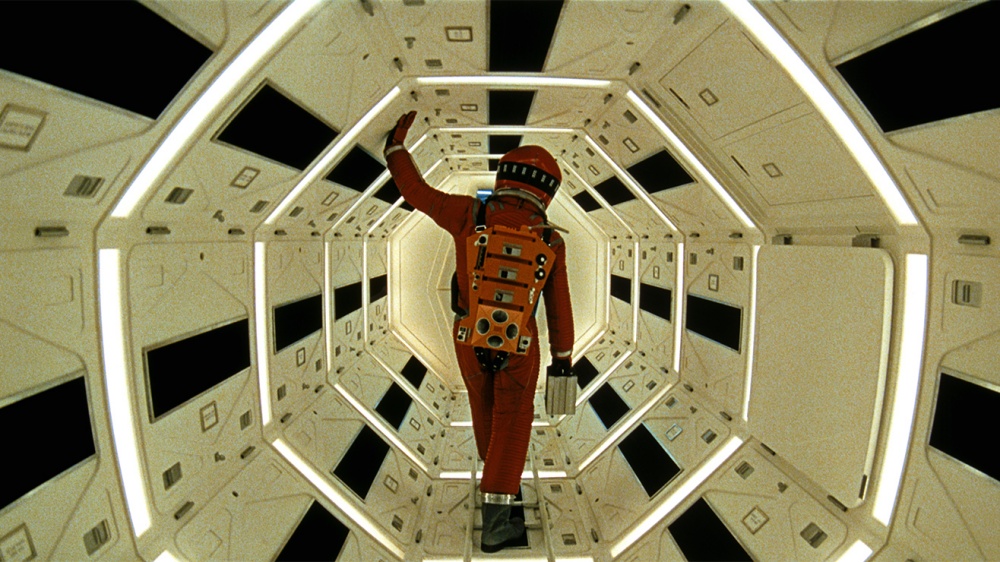Kubrick’s most influential film still remains way ahead of its time and is arguably the greatest sci-fi film ever made.
Dir. Stanley Kubrick
1968 | UK/USA | Sci-Fi/Mystery | 149 mins | 2.20:1 | English
PG (passed clean)
Cast: Keir Dullea, Gary Lockwood, William Sylvester
Plot: Mankind finds a mysterious artifact buried on the moon and, with the intelligent computer HAL, sets off on a quest.
Awards: Won 1 Oscar – Best Special Visual Effects. Nom. for 3 Oscars – Best Director, Best Original Screenplay, Best Art Direction.
Source: Warner Bros (Park Circus)
Accessibility Index
Subject Matter: Philosophical
Narrative Style: Complex
Pace: Slow
Audience Type: Slightly Arthouse

(Reviewed on IMAX – first published 21 Sep 2018)
Spoilers: No
Stanley Kubrick’s 2001: A Space Odyssey is to me the greatest science-fiction picture ever made. Even if something similar is attempted today, it will inevitably still be streets behind the influential masterpiece because of two main reasons.
First, the original movie was released in 1968, without the aid and distraction of computer visual effects; and second, it remains to be one of the medium’s most ambitious and indelible portrayals of the unknown.
A meditative journey into the nature of our existence like no other, 2001 explores many themes, most notably that of existentialism, man versus machine, and the cycle of life.
In the beginning, Kubrick brings us back to “The Dawn of Man”, when apes were the precursor to Man. The quest for survival slowly turns violent, from obtaining food and avoiding predators to forming clans for territorial rights. This is greatly juxtaposed with colonised space, which forms the bulk of the picture’s remaining two hours.
In one of the most astonishing match-cum-jump cuts ever, we see an ape-human throw a bone up into the sky and as gravity pulls it down in one swift motion, the bone suddenly becomes an image of a satellite (shaped like that bone) floating in dark, infinite (and gravity-less) space. In that mind-blowing split moment, we are hurtled thousands of years into the future. And with that comes themes of technology going amok and Man’s (im)mortality.
The defining motif that brings these themes together is the monolith, a rectangular grey block made of an unknown inert material that appears in four key moments in the film. It is simultaneously a symbol of mystery and the ultimate black box, one that might contain the answers to that we desperately seek.
“Open the pod bay doors, HAL.”
Kubrick’s unique melding of imagery to the sound of classical music (both the entrancingly melodious and the eerily dissonant) is poetry in motion. Man-made space objects rotate and float across the length of the screen, as slow as the director would allow them to move so as to imitate the physics of motion in space.
Working together with the famous Arthur C. Clarke (who co-wrote the screenplay), Kubrick brought astounding realism to his craft, building models of space objects to their finest details, and was rewarded with the only competitive Oscar in his career for, of all things, Best Special Visual Effects.
Released at a time when space exploration was real and promising, 2001 still remains way ahead of its time 50 years on, functioning as both a cautionary tale and an inspirational tone poem—one that has influenced countless science-fiction films in the decades since.
To see this (again) in IMAX is to experience rebirth, both metaphorically and philosophically, perhaps even psychoanalytically and spiritually—where the cinema is the Mother’s womb and Kubrick the Father, who art in heaven.
Grade: A+
Trailer:
Music:












[…] a way, Tarkovsky’s film is the anti-2001: A Space Odyssey (1968), described by the Russian director as “sterile”, which he saw only years after […]
LikeLike
[…] probably rivals in audaciousness to the famous bone-to-satellite jump-cut scene in Kubrick’s 2001: A Space Odyssey […]
LikeLike
[…] at its heart a tribute to the roots of true science-fiction films best exemplified by Kubrick’s 2001: A Space Odyssey (1968) or Tarkovsky’s Solaris (1972). Starring Cillian Murphy as Robert Capa, who with a small […]
LikeLike
[…] ambivalent ending leaves us with more doubts to grapple with. Though not as groundbreaking as 2001: A Space Odyssey (1968) or as satirically potent as Dr. Strangelove (1964), A Clockwork Orange remains to be a […]
LikeLike
[…] the late Stanley Kubrick. The director of influential masterpieces such as Paths of Glory (1957), 2001: A Space Odyssey (1968) and A Clockwork Orange (1971), Kubrick is easily one of the greatest filmmakers of all […]
LikeLike
[…] Eternality Tan: “Kubrick’s most influential film still remains way ahead of its time and is arguably the greatest sci-fi film ever made.” […]
LikeLiked by 1 person
[…] visuals of large, turning mechanisms of an oil well remind me of the rotating space stations of 2001: A Space Odyssey (1968). Not to mention the bowling alley shot in the climax – Kubrickian is the […]
LikeLike
[…] critics would mention Stanley Kubrick’s 2001: A Space Odyssey (1968) in their review of Interstellar, but I will avoid that, because I wish to focus on […]
LikeLike
[…] illustrious Steven Spielberg, who as a tribute to the great director of Dr. Strangelove (1964), 2001: A Space Odyssey (1968), and A Clockwork Orange (1971), decided to complete the film for […]
LikeLike
[…] just one line: The Tree of Life is Days of Heaven (1978) meets 2001: A Space Odyssey (1968). It explores big, existential themes of life, death, the birth of the universe, and the […]
LikeLike
[…] is also in a more symbolic mode here—not since Kubrick’s 2001: A Space Odyssey (1968) has the use of an animal bone in cinema been so metaphorically rewarding. While Wind […]
LikeLike
[…] of suspense. The art direction and set decoration are fantastic with influences from Kubrick’s 2001: A Space Odyssey (1968). This is most evident in the interior design of the Nostromo which gives a sense of […]
LikeLike
[…] is my favourite science-fiction film after Kubrick’s 2001: A Space Odyssey (1968). It is also my favourite Ridley Scott picture. He hasn’t done a better picture since, […]
LikeLike
[…] was years before the historic Apollo 11 moon landing in 1969, and Kubrick’s landmark 2001: A Space Odyssey (1968), which apparently had been inspired to some degree by Polak’s […]
LikeLike
[…] are brought up, as well as different music bands, and in one scene, a brief playback of Kubrick’s 2001: A Space Odyssey […]
LikeLike